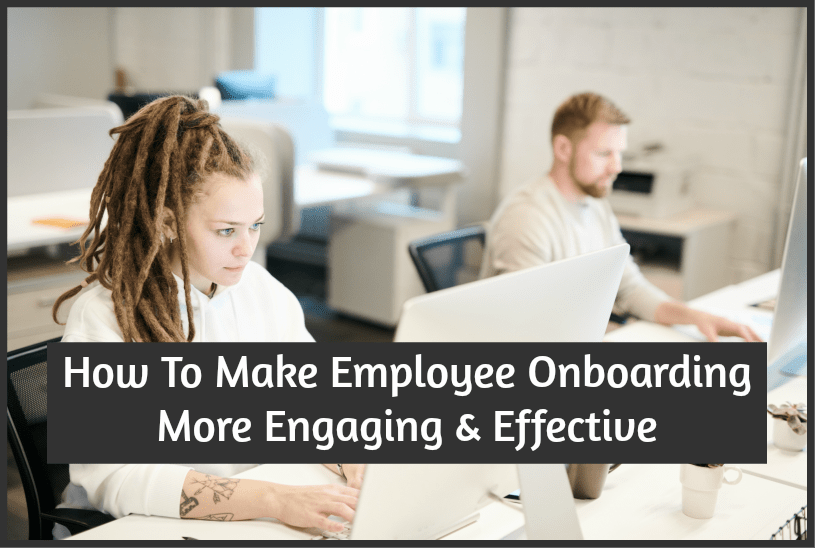
How To Make Employee Onboarding More Engaging And Effective
Finding quality candidates can be tough. According to a recent study, nearly 40% of employees who receive poor job training exit the company within the first year. Furthermore, nearly 70% of these employers noted that this was a bigger challenge now than it was in the past year. Training your new employees to do their job is thus one of the most critical responsibilities of any business.
Employees with a negative onboarding experience are twice as likely to leave a company. Employees will also leave companies that do not provide sufficient training during the onboarding progress. If employees do stay with a company in spite of these complaints, there is a good chance that they are dragging down the productivity of the organization. There are enough statistics about the importance of onboarding and its impact on engagement, time-to-performance and retention. Here then are a few techniques that can help businesses create onboarding programs that are as engaging as they are effective.
Microlearning

A microlearning approach eliminates the information overload of traditional onboarding.
Microlearning delivers one self-contained unit of actionable knowledge at a time as part of a strategic training sequence. It breaks down complex information into more manageable bytes to increase engagement, retention and accelerate the training process.
Microlearning also enables employees to determine their own time and pace of consumption, giving them the flexibility to personalize the experience to their individual requirements. Many employee onboarding software tools today come with microlearning features that allow employees to begin training even before their first day. This frees up HR resources who may now focus on more substantial face-to-face interactive sessions.
Gamification
PwC Hungary launched a game on the company’s career website to pre-educate potential job candidates about its vision, services and skills needed for success.
As a result, time spent on the website went up by a factor of nine and candidates were better prepared for the interview as well as the onboarding phase.
Gamification streamlines the entire recruitment and onboarding process making it much easier on both candidates and HR teams.
It allows businesses to prioritize learning objectives, streamline information delivery, consumption and retention, and align onboarding programs with business goals. This is especially valuable for complex roles where gamification can build teamwork by enabling new hires to connect with peers and seniors in collaborative learning and problem solving exercises.
Case studies & real-life scenarios
Context is key to learning, and case-studies and real-life scenarios provide the context that augments knowledge assimilation retention.
- Scenario-based learning is a fairly commonplace technique in training programs related to topics such as sector compliance as it allows trainees to practice their skills with real world situations without violating industry norms that can put your business licenses at risk.
This is also relevant in onboarding as it immerses employees in an interactive storyline and gives the opportunity to apply information that they have learned in a practical setting.
- Branching scenarios, simulations that branch out differently depending on user decisions, are especially effective in exposing employees to complex business-related situations and in understanding how they respond in real-time.
These approaches can generate key insights into employee skill and knowledge gaps, decision-making and judgment and help tailor programs to specific learning outcomes.
Transparent goals and expectations
Every onboarding program is designed with some expectations and goals in mind. One of the best ways to make it realistic is to add a timeline so that it makes it possible to track progression of goals and introduce course corrections if required.
Companies need to develop a 90-day plan, the actual period being subjective, along with a detailed roadmap and key milestones that have to be crossed. The plan lists all the short-term and long-term learning goals for an employee along with the resources and inputs required to enable it. Providing employees with a plan gives them a clear understanding of company expectations, prepares them for the course ahead and allows them to evaluate their progress as they go.
Effective two-way feedback
Most modern onboarding programs are designed to be collaborative and with some kind of formal feedback mechanism. This includes one-on-sessions and quantitative and qualitative surveys. The objective here is for companies to gather information about employee experiences and perceptions at various points during the onboarding process.
There are a range of benefits for eliciting feedback from new hires, starting with the fact that employees like to be heard. The feedback can also provide valuable insights in terms of employee perceptions of the company and prospective areas of improvement in the onboarding process.
Many employees also thrive on instant feedback. So, one-on-one sessions with direct managers or senior management can help new hires feel recognized and valued.
Conclusion
A successful onboarding program has a tremendous impact on employee engagement, productivity and retention.
But in order to be successful, they have to be flexible, practical and transparent. Techniques like microlearning and gamification eliminate the tedium of onboarding even while augmenting its effectiveness and enabling employees to adapt onboarding to their unique learning needs. Case studies and real-life scenarios elevate onboarding from a mere theoretical exercise to a program with practical value.
© New To HR


